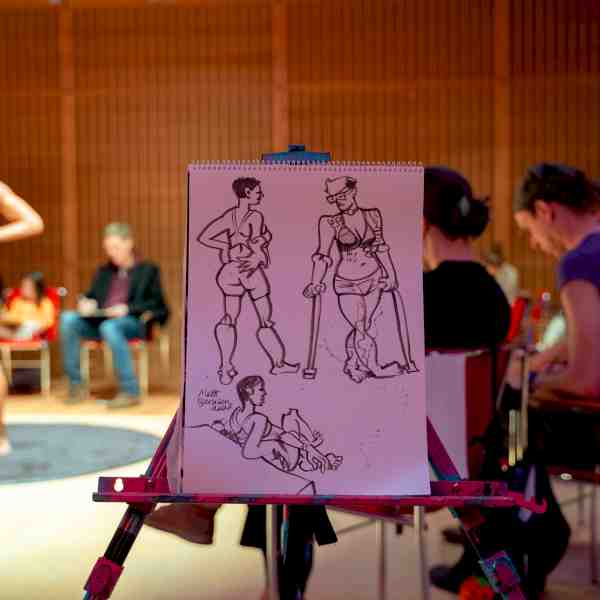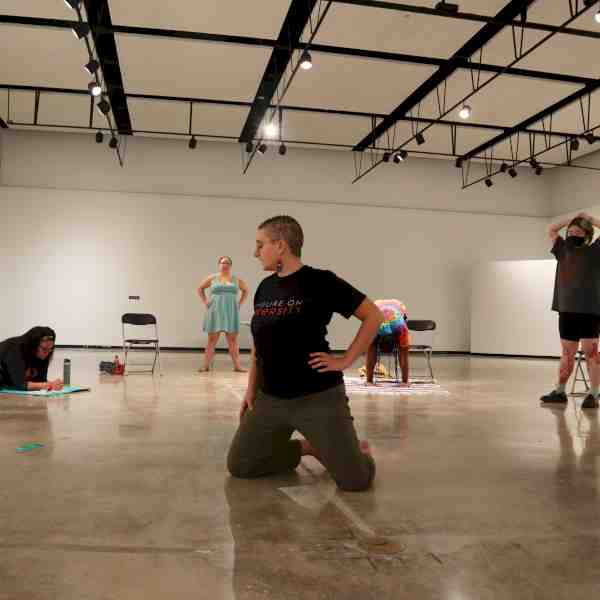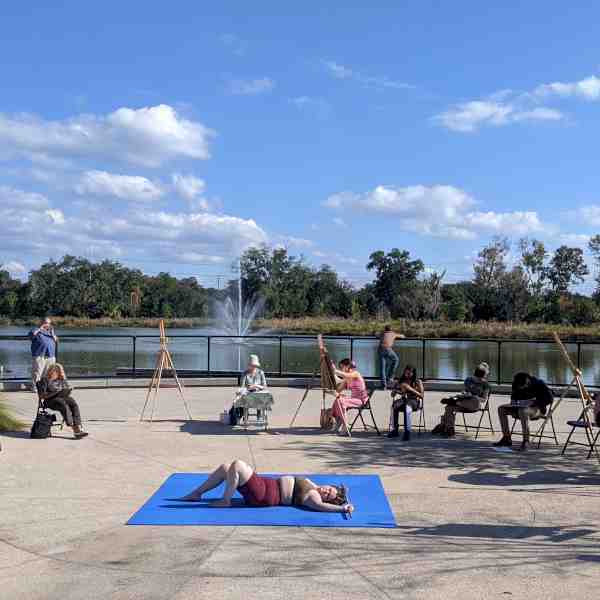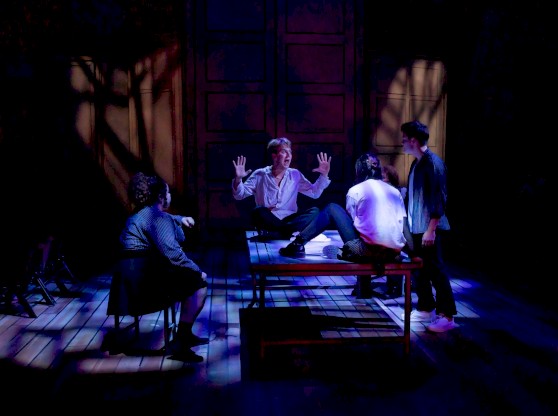Figure drawing is a standard practice in Western art education. Studio art students are likely to take courses that include sketching the human figure from sculpted busts and live nude models.
Traditionally, the figurative references used in classrooms tend to resemble the statues and drawings of Greek and Roman gods, with features that are Eurocentric, thin or athletic, cisgender, and able-bodied.
Angela DeCarlis is a portrait painter and former figure model who first began posing in Philadelphia while studying at the Pennsylvania Academy of the Fine Arts. After moving to Boston, they began to serve as a co-moderator for a Facebook group that helped organize and advocate for life models working in that area.
“The homogeneity of the group became very apparent to me,” DeCarlis said. “I noticed we were pretty much all white people, all visibly able-bodied, thin young white women and older white men.”
While there were some exceptions and while some models like DeCarlis appeared cisgender and able-bodied without identifying as such, the overall lack of visible diversity in their community was apparent.
DeCarlis put together their first Figure On Diversity workshop in hopes of increasing access to figure modeling for people who hold visible marginalized identities. The workshop invited people who identify as underrepresented in fine art and media—whether that be by race, gender, body type, or visible disability—to try out nude figure modeling.
They only anticipated holding one workshop, but four years later, DeCarlis, who is pursuing a Master of Fine Arts degree in the UF School of Art and Art History, has presented multiple workshops. Through their MFA research, they continue to identify and confront barriers to figure modeling.
Some of these barriers have to do with the infrastructure and tradition of the practice, DeCarlis said. Figure models are often expected to pose atop a dias, or model stand, leaving out those who may use a wheelchair or other mobility aid. Model booking calls are typically made with a designation of either male or female, preventing individuals who have identities outside the gender binary from participating.
As a graduate student, DeCarlis is also an instructor for courses in Figure Drawing 1 and Painting From Observation. Increasing the diversity of models in the classroom can be pivotal in preparing students to enter art and design fields.
“Some of my students are going to become illustrators for children’s books and some are going to become graphic designers and make advertisements,” DeCarlis said. “Ultimately, the bodies included in their education will impact what they’re able to produce in terms of the media that we all consume.”
Figure modeling also offers important benefits to the models themselves. Nude modeling, where one allows artists to attentively draw, paint or sculpt the details of your body, is an inherently vulnerable situation. But it can also be empowering to be seen authentically, as innately beautiful and worthy of representation by artists.
“I’ve spoken to multiple models who started figure modeling while in a low place when they were not having a good relationship with their body or with their mental health,” DeCarlis said. “They have told me plainly that figure modeling has saved their lives. It’s healing. I’m really interested in who has access to that experience.”
DeCarlis’s workshops have expanded to reach international audiences, with recent virtual sessions engaging people from around the world. They have also grown Figure On Diversity to create new artistic references and guidebooks.
One of those projects, called BustEd, focuses on creating new plaster busts, which DeCarlis said are often used as a stepping stone between learning to paint a banana and learning to paint a person. These non-living figurative reference materials can be of enlarged features, such as a nose or a mouth, or full head-and-shoulders busts, but they are based almost exclusively on antique Greco-Roman masterpieces.
DeCarlis is collaborating with sculptor Morgan Yacoe, an alumna of the School of Art and Art History and currently a research coordinator in the UF Center for Arts in Medicine. The team received funding to create three busts, whose subjects include a young Ghanaian man, an Asian nonbinary person, and a 50-year-old blind Black woman, who DeCarlis said has had a unique interaction with her sculpture.
“For this project, being sculptural, that model has been able to engage with the likeness that’s been made of her in a way that she wouldn’t be able to engage with if it were painted or drawn,” DeCarlis said. “That’s been a really powerful and exciting experience.”
The busts are nearly complete, and DeCarlis plans to use them in the figure drawing class they teach in the spring.
DeCarlis is also working on a series of guidebooks called Modeling Modeling. They said few resources exist for figure models, and none of them account for the needs of people with marginalized identities. Some available guidebooks reinforce barriers, such as framing the idea that breaking a pose is unprofessional.
“When I hear that as a disabled model,” DeCarlis said, “I hear that the most unprofessional thing I can do is take care of my body when it’s hurting.”
DeCarlis is planning three volumes: the first is catered to figure models, the second to those who work with models, and the third for folks who book models.
The third volume is the most unique contribution to the series, DeCarlis said, as it offers specific training to folks who may not be experts in figure modeling.
“No one goes to school to become a models coordinator,” they said. “But the folks who book models become a kind of gatekeeper of the education that the students receive. How they book the models can impact who ends up in the classroom.”
DeCarlis is continuing to expand Figure On Diversity, hiring new team members to design the guidebooks and to help run the new outdoor community event series, Figure Drawing in the Parks, supported by the City of Gainesville Parks, Recreation and Cultural Affairs Department.
Meghan Moe Beitiks, an interdisciplinary studio art lecturer in the School of Art and Art History, is a faculty member of DeCarlis's thesis committee.
"The fact that current art pedagogies and practices are derived from Western traditions that center cis, white, able bodies and perspectives is challenging to many," Beitiks said. "Angela DeCarlis's work with Figure On Diversity, BustEd and other initiatives seeks to build on those traditions of figure drawing and modeling while expanding their focus and scope to embrace the reality of the human experience, not just a canonized version of it. One of the most important aspects of the project is the way that DeCarlis collaborates with similar organizers—other figure drawing programs and modeling initiatives that center diversity—to support the centering of marginalized bodies across the globe."
In the coming months, DeCarlis plans to complete their Master of Fine Arts thesis to graduate from UF in spring 2021.
"DeCarlis is embodying their professional practice before completing their grad program, which is an ideal relationship to grad school," Beitiks said. "It should be a place to access resources and support that allow you to become more fully who you are as an artist, to further your contemporary practice, and to challenge your process."
DeCarlis said making an impact on the university was important to them.
“I love being in the position that I’m in because I get to actively change the institution I’m a part of. Even though I leave UF in the spring, I know that I have a legacy here in terms of access in education, which is pretty exciting,” they said. “That’s what I want to do everywhere."
You can learn more about Figure On Diversity and Angela DeCarlis on their websites.






